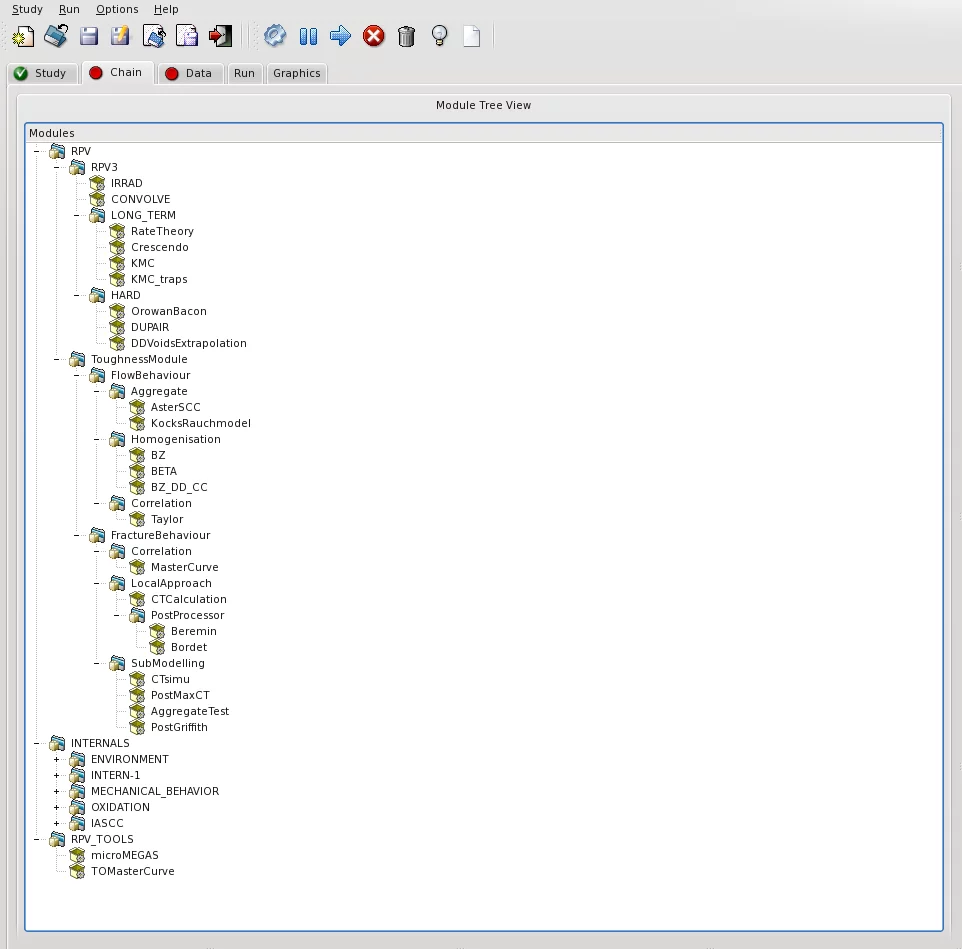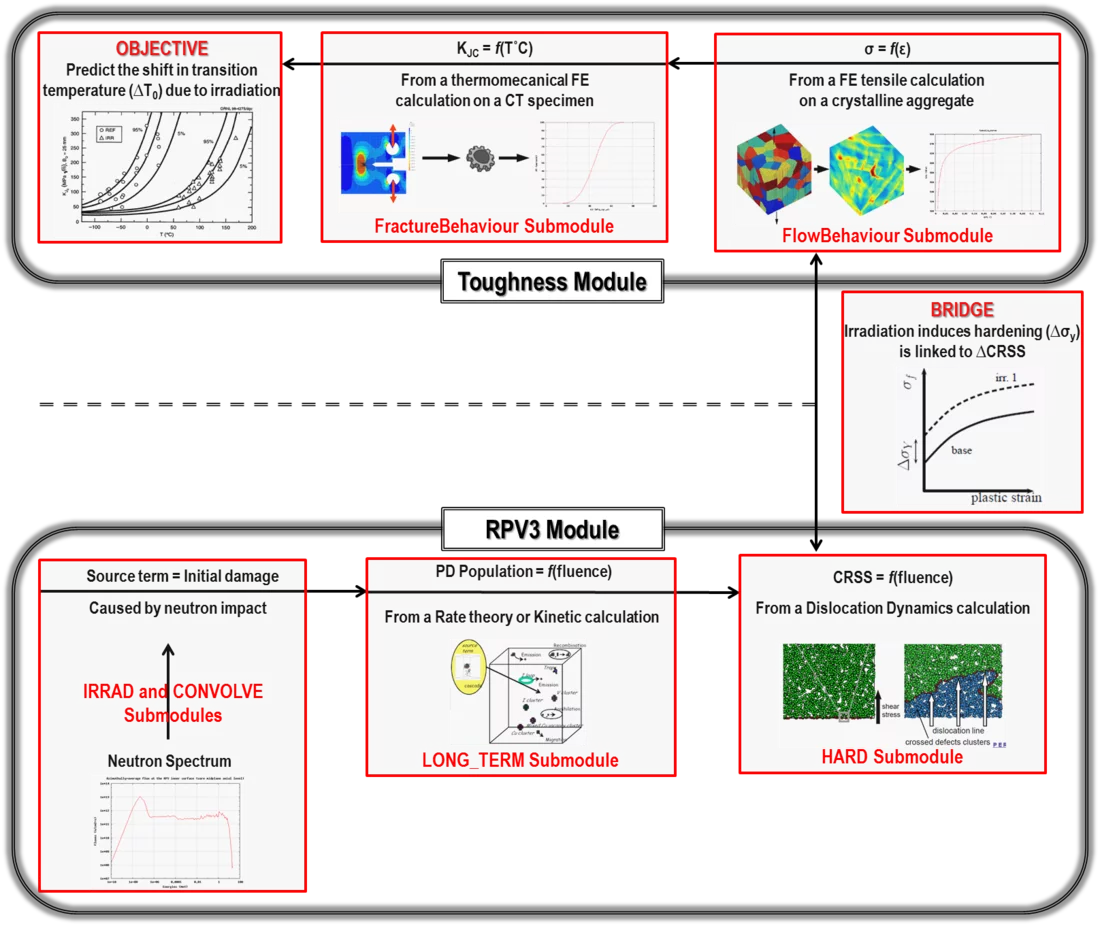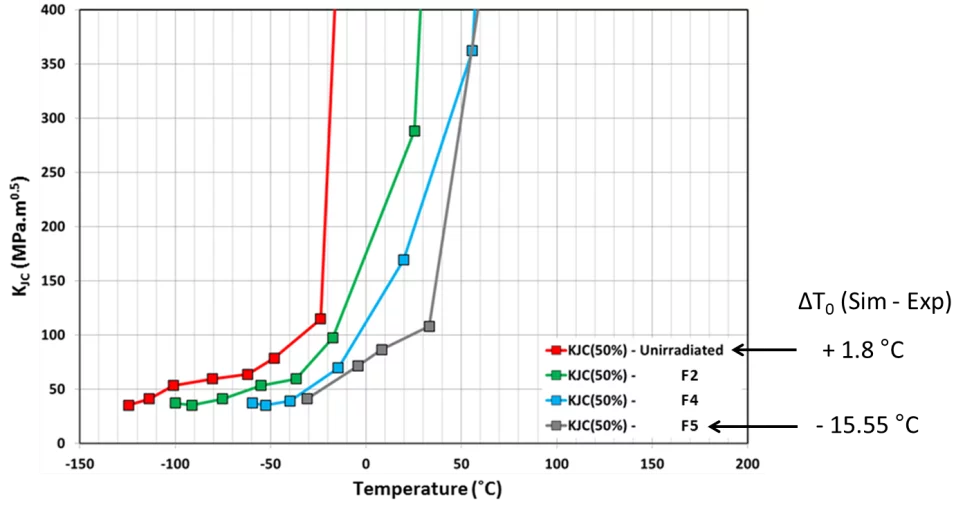Ensuring the highest level of safety is the cornerstone of nuclear power plant operation. This embeds challenges at neutronics, thermal-hydraulics and materials levels. The latter includes nuclear fuel and structural materials mainly. Among structural materials, the reactor pressure vessel (RPV) steel monopolizes the most attention, because the RPV is one of the main safety barriers and it is irreplaceable throughout the lifetime of the power plant. In operation, it is exposed to continuous irradiation from fast neutrons (E > 1 MeV) over its service life. Yet, even at relatively low recorded fluences, this irradiation is sufficient to produce severe embrittlement. This represents a serious threat for good performance and safety of the reactor, as it could lead to a catastrophic failure of the RPV by brittle fracture in case of an accidental scenario. Embrittlement is fostered by the hardening (yield stress increase) of the steel and is a consequence of the continuous shift of the ductile-to-brittle transition temperature (ΔT). The transition temperature is defined as the reference temperature at which the steel behaviour changes from a ductile to a brittle fracture upon applied stress. As a result, the steel that was initially ductile in temperature range of operation could suddenly become brittle after accumulating some irradiation dose.
Radiation damage is a very complex process that involves several phenomena covering a large spread of time and length scales:
- The primary damage, resulting from the impact of energetic neutrons.
- The microstructure evolution, i.e. the formation from primary defects of solute and point defect clusters
- The hardening, as a consequence of the pinning of moving dislocations.
- The cleavage fracture enhancement, stemming from a decrease in fracture toughness, and fostering brittle failure for any flaw or critical stress concentration.
There are computational models and codes that exist at each scale to study the corresponding phenomenon involved in the process of radiation damage. They operate separately and this does not help giving a complete and accurate picture of radiation damage. The significant step achieved by PERFORM-60 has been to propose a computation platform that integrates in modules and sub-modules the most advanced physics-based models at each scale, as described in Figure 1 (detailed descriptions of the integrated models can be found in the references 1 and 2). Moreover, this integration is performed in a chaining scheme ensuring a consistent link and transfer of relevant data among the modules.
As a contribution of the Paul Scherrer Institute to the H2020 EU project SOTERIA, the platform PERFORM-60 has been rigorously assessed on a real case study of a Swiss RPV. The assessment has been achieved by comparing and contrasting simulated and experimental transition temperature shift (∆T0) data of a RPV steel representative of a Swiss reactor (T0 is defined as the temperature at which the fracture toughness is 100 MPa·m1/2). The transition temperature shifts have been computed at various fluence levels, by subtracting the transition temperature of the unirradiated steel from that of the irradiated material, i.e. ∆T0 = T0Irradiated – T0Unirradiated. The most challenging part of this work has been to set up the methodology (choice of modules and models in the platform PERFORM-60, assumptions and simplifications) in order to describe the correct fracture behaviour of the unirradiated steel. Once validated, the same methodology has been used to predict the behaviour of the irradiated steel, the only additional work being to define the hardening model due to irradiation. The methodology used is schematically described in Figure 2 and technical details can be found in the reference 3.
The platform PERFORM-60 has been successful in modelling the fracture behaviour of the RPV steel investigated. Figure 3 shows that the simulated T0 has been obtained with an error of +5.07% and -39.37% (respectively for the unirradiated steel and the steel irradiated at the highest fluence) which is reasonable considering the various assumptions and limitations of the models used.
Based on this work and from a user's point of view, our assessment of the platform PERFORM-60 has allowed identifying some weak points that need to be tackled:
- The platform lacks cruelly some ergonomics. A first-time user gets easily lost in this complex structure of modules, sub-modules and wording. We think that some simplifications in the structure of the platform are needed as well as guidelines based on self-explanatory indicators (e.g. level of accuracy, confidence in the results, CPU time range, etc.) to efficiently help the user choosing the right combinations for his purpose.
- The platform requires a substantial amount of preparatory work prior to initiating a study. This consists mostly for a lay person in understanding the basis of the numerous models integrated. This could be easily solved by proposing some case studies based on known industrial common issues, for which a predefined chaining and parametrisation of modules models have been provided.
- The platform lacks a tool to perform sensitivity studies and uncertainty quantification, and these are essential in the field of nuclear safety to assess errors and margins.
Nevertheless, these weak points should not conceal the significant assets of the platform PERFORM-60:
- It is an undeniable state-of-the-art tool to help non-experts in one or more fields involved (neutronics, atomic modelling, rate kinetics, dislocation dynamics, continuum and fracture mechanics) to assess radiation damage effects on RPV steels with a physics-based methodology.
- The multi-scale capabilities of the platform are smartly chained, several models are advanced state-of-the-art, and the “black-box” integration scheme is really appreciable as it prevents the user to directly deal with the codes themselves.
- The platform offers a great modularity as each module (i.e. scale involved) can be an entry or exit point to start or end a study for optimal flexibility.
- It is finally worth noting the very good trade-off between the quality of models involved and the low computational cost required for a study, which can be executed on a laptop within minutes.
Contact
Dr. Ivor Clifford
Steady-State, Transient and Radiation Safety Analyses - System Group (STARS)
Laboratory for Reactor Physics and Thermal-Hydraulics (LRT)
Nuclear Energy and Safety Research Division (NES)
Paul Scherrer Institut
Original Publications
[1] G. Adjanor, S. Bugat, C. Domain and A. Barbu
Overview of the RPV-2 and INTERN-1 packages: From primary damage to microplasticity
J. Nucl. Mater. 406 (2010) 175
DOI: 10.1016/j.jnucmat.2009.09.006
[2] S. Bugat, J. El Gharib, J.-M. Proix and A. Zeghadi
The toughness module of the PERFECT platform: A predictive tool for the fracture toughness of RPV steels
J. Nucl. Mater. 406 (2010) 187
DOI: 10.1016/j.jnucmat.2010.03.019
[3] R. Ngayam-Happy
Assessment of the PERFORM-60 platform for the simulation and prediction of irradiation-induced embrittlement of a RPV steel characteristic of Swiss nuclear reactors
PSI Technical Report TM-41-15-23, November 2015





